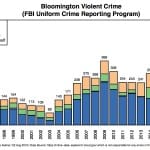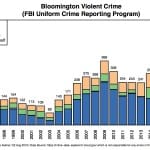Bloomington city councilmembers want more police officers in 2020 budget, more data



Two additional patrol officers, which would bring Bloomington’s total sworn police force to a total of 105, are a part of the 2020 budget that the chief of police, Mike Diekhoff, presented to the city council on Tuesday night.
Some councilmembers told Diekhoff they wanted to see more officers added than just the two. And they wanted more data from Diekhoff as they weigh how to approach the eventual adoption of the budget in October.
Council president Dave Rollo pointed to violent crime numbers for Bloomington, which have increased since 2013. Rollo also pointed out that adding two officers would make 1.2 officers per 1,000 residents (105/85) in Bloomington, which is lower than the national average. So Rollo wanted Diekhoff to provide more data on staffing levels for BPD relative to the population, going back 10 years.
Paid overtime in the department is one way to analyze appropriate staffing levels. The budget memo provided to the council pegged 2017 actual overtime paid at $689,337 and $327,481 budgeted for 2020. One of the budget goals that Diekhoff presented to the council was to decrease overtime costs. Councilmembers Dorothy Granger and Susan Sandberg wanted more data on the amount of overtime that’s been paid.
Also catching Sandberg’s eye on a slide in Diekhoff’s presentation, were current staffing levels relative to approved positions. Out of the 103 sworn officer positions approved in the department’s budget, only 95 are currently filled. That prompted Sandberg to ask Diekhoff if recruitment and retention are a challenge. The chief replied: “It’s getting harder and harder. People don’t want to be police officers anymore. There’s a lot of scrutiny… people look at the job and there’s a lot of violence that you deal with, and a lot of just, negativity.”
Sandberg wondered: “Do we need more officers to make sure that we’re spreading the load and not asking a lot of the ones that we have?” Sandberg also indicated some skepticism about the idea that Mayor John Hamilton had talked about in his 2020 budget address. He said he’d directed department heads to explore incentives like take-home cars and housing supports to improve retention of employees and encourage them to live inside the city limits. She wondered if simply hiring more officers might be “a smarter use of the dollars.”
Steve Volan expressed agreement with Rollo, Sandberg and Granger, saying, “This has been a consistent question for a few years: Are we hiring enough?”
On the subject of more officers, Diekhoff didn’t defend the two as the number he wanted, but rather a number that was appropriate given the city’s other needs: “I would love to have more officers, but I also understand that we are one department in the city and there are lots of requests for people.”
For the police department, the $20.6 million proposed for 2020, compared to $21.4 million in 2019, is a reduction of around $800,000. That reflects a $1.3 million reduction in capital outlays.
Volan also said that “passing” on the straw vote that the council would take was not an expression of a lack of support. His vote of “pass” would just be a signal that he thinks it’s a question that should be seriously explored between now and the actual formal budget hearings in September.
Passing on the straw vote were Volan, Sandberg, Granger and Rollo. Voting yes were Jim Sims, Andy Ruff, Chris Sturbaum and Isabel Piedmont-Smith. Allison Chopra was absent.
Piedmont-Smith’s yes vote came after she expressed some frustration about the availability of the dataset that logs the uses of the Lenco BearCat armored truck. The purchase of the truck in 2018 generated significant controversy. The council later enacted legislation restricting the use of the vehicle and equipment associated with it. For example, BPD can’t mount a water cannon on the truck and use it to control crowds.
Diekhoff told Piedmont-Smith the vehicle had been used for the first time in 2019 that same day.
Piedmont-Smith also expressed support for Diekhoff’s goal of identifying the physical place where a law-enforcement-assisted diversion program could be established, which would support rehabilitation of non-violent offenders.
Crime Trends
The general characterization of crime in Bloomington given by councilmember Dave Rollo at Tuesday’s meeting was that property crimes were pretty steady, but violent crimes saw an upward trend. That’s consistent with data from the FBI’s Uniform Crime Reporting program.


Chief Diekhoff generally agreed with Rollo’s summary: “I don’t disagree with that.” But Diekhoff gave some caveats.
What the department has to report as a violent crime, Diekhoff said, covers a wide range. An aggravated battery, where someone is struck and injured, is a lot different from someone getting shot or sexually assaulted, he said. As home to a major university, Bloomington sees a lot of assaults and batteries, he said. “You have to look at our violent crime and delve into it deeper than just what the Uniform Crime Report shows,” he said.
Staffing Levels
Rollo framed the question of staffing in terms of officers per thousand residents. That’s a metric used by the FBI. The FBI Uniform Crime Reporting program includes those figures broken down by state and by agency within the state. For the state of Indiana, UCR gives 1.7 as the average number of sworn officers per thousand.
If Bloomington hit that average for its roughly 85,000 residents, that would work out to 145 sworn officers, compared to the 105 authorized positions that are in the 2020 proposed budget.
Responding to a question from The Beacon after Tuesday’s budget hearing, Rollo said that for his calculations on the number of sworn officers per thousand, he was not factoring in the sworn officers in the Indiana University Police Department. The latest year for which IUPD data is available from UCR is 2016—38 officers. The IUPD website puts the figure at 45 in 2019.
Based on the numbers The Beacon pulled from UCR for some other university communities. Bloomington’s police staffing levels are on the lower end—now and historically. (The numbers for city agencies don’t include figures for the campus police, which are available separately.)
Most of the departments plotted in the chart below show a stable or maybe slightly downward trend. A notable contrast is the city of Ann Arbor, which fell from 1.6 officers per thousand residents in 1996 to 1.0 in 2017.





Comments ()